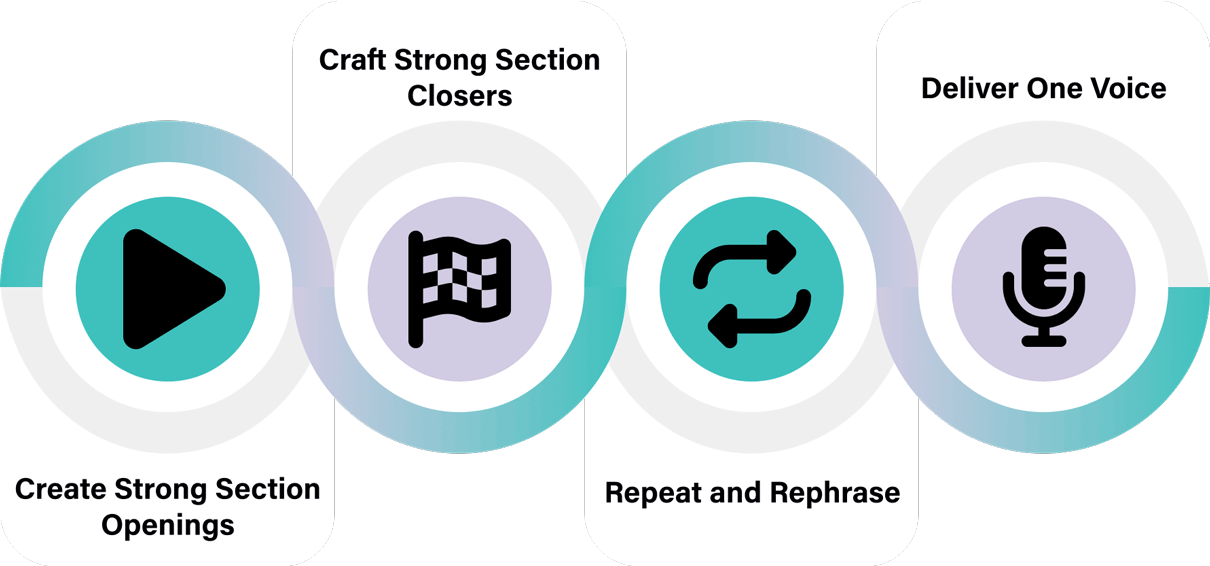Here, we delve into persuasive proposal writing techniques for an influential, page-turning best seller. Learn how to craft a compelling document based on your client needs, your own expertise, focusing on benefits, adding emotion and credible arguments that ultimately secure more deals.
Know Your Audience
Crafting a compelling document requires a deep understanding of your audience. Before putting pen to paper (or fingers to keys), take time to identify and understand who you are writing to.
By knowing your audience, you transform a generic document into a compelling proposal. One that paves the way for a successful outcome. This also focuses your writing time to avoid mid-stream rewrites.

- Decision Nuances. Read the RFP. Then, read between the lines. What were they thinking about? What are they worrying about? These details will help you communicate your understanding of the nuances behind their decision.
- People Pains. Who is reading your offer? Thought leaders with big dreams? Project staff with staffing concerns? Address their specific pains. A people-focused bid engages the people behind the project.
- Value Proposition. A clear and compelling value proposition grabs attention. Focus on customer needs, not features. Be clear and concise, but don’t be afraid to be bold. Differentiate yourself. These details help readers
cut through the technical details and quickly grasp your position.
Suggested article: Proposal Writing With AI
Educate Your Readers
Proposals are about more than just listing your solutions and services. They are also a critical component of a well-defined proposal management approach, which focuses on educating your readers by showcasing your expertise and highlighting your value.
Educational content provides insights that bridge knowledge gaps and build trust.
- Start with Why. Start with the context behind your offer. Where is this project coming from? Paint a vivid picture of why this project is important. Include the potential consequences if left unaddressed. This makes your solution naturally more obvious, which empowers your value proposition.
- Address Knowledge Gaps. Identify potential knowledge gaps your readers might have regarding your solution. Or the technical aspects of their project. Break down complex information into digestible chunks and use visuals to fill in the gaps.
- Anticipate Objections. Consider potential doubts or objections. For example, if your solution requires a significant investment or a lengthy project timeline. This positions you as a problem-solver with foresight.
Persuade Hearts and Minds
By educating your reader on the context, you establish yourself as a thoughtful partner. By weaving in these writing techniques, you transform your offer into a captivating call to action that leaves a lasting impression.

- Focus on Benefits, Not Features. Celebrate the benefits of your features. Explain how each addresses the reader's needs. Instead of, “Our software has a user-friendly interface,” say “Our intuitive interface accelerates adoption rates.” This helps readers stay focused on your value and tangible results.
- Leverage the Power of Story. Celebrate your success stories. Showcase how your solution has positively impacted others. This helps readers visualize a prosperous future with you and your offering.
- Focus on the Outcomes. Share how your solution boosts bottom lines and changes peoples lives. For example, increased revenue, improved efficiency, or happier employees and customers. This emphasizes the value beyond the technical specifications, and beyond this project.
Add a Touch of Emotion
Facts and figures tell the story, but emotions make them care. Adding a touch of emotion connects with readers on a deeper level. Emotions like excitement, hope, or concern grab attention and make your offer more engaging and memorable.
A persuasive offer doesn’t just represent a compelling solution; it acknowledges the challenges and frustrations your client faces. Emotion can effectively convey empathy and understanding, building trust and rapport with the reader. It can also help create a sense of urgency, motivating readers to take action.
- Speak to Their Fears. Acknowledge their anxieties. What keeps them up at night? This demonstrates you and the reader are squarely on the same page. It also shows you’ve anticipated their worries and have solutions in mind.
- Speak to Their Aspirations. Frame your narrative around how your solution directly contributes to their aspirations. Weave in words and phrases that evoke the positive outcomes the reader desires. This positions your solution as a springboard for achieving their goals.
- Emphasize the Human Element. Put yourself in the reader's shoes and see the project from their perspective. Tell stories of how your work has positively affected people's lives. Empathy reminds readers that people, not necessarily data, make the decision.
Relevant Content to Persuasive Proposal Writing:
More on convincing your clients below!



Emphasize for Impact
Emphasis grabs reader’s attention, guiding them through your ideas. This ensures the reader's focus is on the aspects you want them to understand and remember most.
Emphasis also conveys confidence in your ideas. It shows you’ve carefully considered the content and know what specific points deserve extra attention. This reinforces the credibility of your arguments.

- Create Strong Section Openings. Capture the reader's attention with a strong opening statement. Highlight your value proposition and set expectations that motivate the reader. This is a great way to keep them reading, not skimming.
- Craft Strong Section Closers. Leave a lasting impression with a strong closing statement. This reinforces key points, leaving readers with a strong sense of accomplishment and confidence. It also serves as a strong transition to the next section.
- Repeat and Rephrase. Bring structure and rhythm to your proposal by strategically repeating and rephrasing. Both emphasize important topics and noteworthy details. In fact, studies show they are more likely to stay in a person's mind. And even convince them of its truth.
- Deliver One Voice. Use one voice to emphasize your reliable, clear message. Be careful to avoid shifting between tone which can come across as unprofessional and lacking in focus. One voice eliminates distractions, helping the reader focus on the content.
Influence with Layout
We employ persuasive writing techniques because they help us capture the reader's attention and follow our line of thinking. Using similar techniques with our proposal layouts can also deliver a surprisingly impactful outcome.
A effective format makes your proposal easier to understand and navigate. With a few additions, it can also help readers feel more positive about your message.
- Allocate Space. Allocate more space to important topics. Use it to guide readers and signal transitions and connections between ideas. Space provides strong cues for topics worthy of their attention.
- Deploy Call-out Boxes. Isolate important information. Call-out boxes draw the reader’s attention and emphasize important information. They are also handy for responding to reader's thoughts or questions as they read, allaying their concerns. .
- Leverage Similarity. Connect similar or adjacent ideas or claims with a visible trait, for example, color or shape. In design, similarity connects ideas, so readers naturally perceive them as part of the same group. A great way for bridging complex concepts.
Tools for Writing Persuasive Proposals
Let’s be honest, finding time to write persuasively can feel like a luxury. So, here are some modern tools that can free up precious time to think and develop more complex narratives that resonate with evaluators.
- Content Library. Save time for high-quality writing with a content library. A library stocked with accurate, reusable content, including images, eliminates repetitive writing while bringing consistency.
- Templates. Save time for reemphasizing your value proposition with reusable templates. Pre-formatted templates jumpstart writing while enforcing your standards throughout development. They also ensure you allocate enough space to important topics.
- Co-authoring. Accelerate writing by working together, real-time. Co-authoring eliminates emails, version control issues, and delays that waste precious writing time. It also brings together different experts for sharing insights and info that strengthen narratives more quickly.
- Workflow Automation. Automate your coordination workflow, including tasks and deadlines, status and progress. Workflow automation streamlines day-to-day logistics, eliminates confusion and accelerates hand-offs. It also keeps your finger on the pulse of status and progress.
- AI Suggestion Tools. Super charge your content library with AI suggestions. AI suggestions surface the relevant details you’re searching for faster. So you spend more time on high-impact writing.
A persuasive proposal is a powerful tool for winning business and achieving your goals. Just remember, you're not selling a product or service. You’re offering a solution to a problem. By striking the right balance of the elements above, you’ll create a winning offer readers understand, and can’t help but act on!








